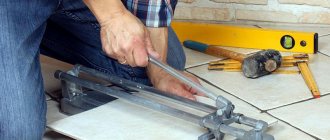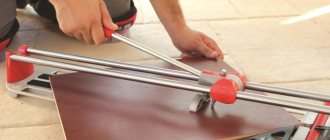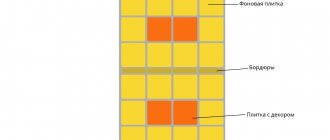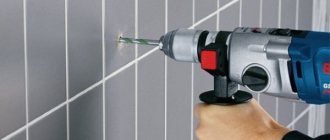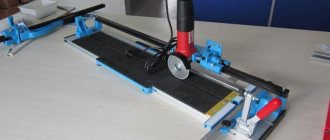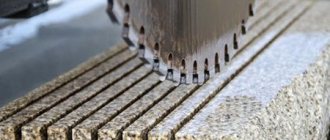Laying ceramic tiles is not complete without trimming or cutting them to the required size. You have to cut the tiles in the corners of the room, when laying along the walls and along the edges of the room, when laying on the floor. When cutting tiles, it is important to get a smooth edge of the tile without chipping, and it is important not to split the tile. To achieve this result, there are several types of special tools for cutting tiles. A tile cutting tool that provides excellent cutting results at a low price per tool is a manual tile cutter, which will be discussed in this article.
How to cut tiles with a tile cutter
A lot has been said about how to cut tiles with a manual tile cutter, but the nuances of using the tool remain. The most important thing is to strictly follow the manufacturer’s instructions: each design “loves” the correct approach.
Cutting tiles with a tile cutter begins with marking . It should be done with something non-erasable: a felt-tip pen, marker or pencil. If you have a laser (optical) target designator, you can do without markings.
Cutting tiles with a tile cutter
Next you need to secure the figure being processed . The intended cutting line should be aligned with the cutting element. Cutting straight and curved, perpendicular or at an angle is different. If necessary, fixtures and guides are used.
The lever lowers and the carriage moves. It is allowed to press it to the surface.
Cutting tiles with a manual tile cutter is accompanied by its splitting . If there is no spontaneous chipping, you can press down the cut with your hand or something heavy. After this, the material will separate.
When cutting tiles with a tile cutter, pay attention to the following:
- It is not recommended to move the carriage repeatedly - there will be nicks and irregularities;
- pressure force – uniform;
- dangling moving parts is unacceptable - everything needs to be tightened until it moves confidently along the trajectory;
- Before starting a cut, it is important to make sure that there is no debris on the future cut.
It’s best to work on unnecessary scraps first.
Cutting with improvised means
To process single workpieces, you can use a stone drill, which is an imitation of a glass cutter. Markings are applied to the surface of the tile and the cutting edge is forcefully drawn along a steel ruler. Then the workpiece is broken using a wooden block or a cylindrical mandrel. To obtain a hole, you need to drill channels along the marking line, and then carefully knock out the central part. The edge turns out uneven and requires long-term processing with a file or coarse sandpaper.
A stone drill imitates a glass cutter, but the edge is uneven.
How to properly cut ceramic tiles with a tile cutter
There are few instructions on how to properly cut ceramic tiles with a tile cutter. And experienced craftsmen are well aware of the features of this material. Among the main points are:
- How to cut porcelain tiles with a tile cutter without first soaking is a difficult question.
The properties of ceramic options and porcelain stoneware are such that for accurate and confident cutting it requires soaking. All processed material must be kept under water for a while until the structure is saturated with moisture. This will result in pliability and less chance of chipping. The average soaking time is from half an hour to an hour.
- What exactly should you cut?
It is important not how to cut tiles with a tile cutter, but which ones: it is optimal to prepare small and medium thickness of the material. It is recommended to purchase according to thickness: thick material will have to be cut in 2 approaches (on both sides). This will increase time consumption and increase waste.
- How to properly cut a ceramic or other surface with a tile cutter?
The whole process is performed in exactly the same way as for other types of coatings. But it is important to make allowances for high strength. This means that processing will require greater pressing and breaking forces.
Basic design and technological capabilities
Tile cutter is a generalized name for construction tools for straight, curved or even shaped cutting of tiles. The classification of the variety of these tools is based on the type of drive movement. So, tile cutters can be:
- Manual;
- Mechanized or electric.
A manual tile cutter consists of a base - a frame, a carriage with a roller and a handle. Its operating principle is similar to that of a regular glass cutter: a cutting roller is used to cut the glaze of the tile. At this moment it is clamped in the body like pliers. After obtaining a cut of the glaze, the tiles are broken off along it. To obtain a more even and accurate cut, guides are used that are adjusted to the tile clamping field. Sometimes tabletop manual tile cutter
An electric tile cutter is a device equipped with an electric drive that rotates a diamond cutting disc. The principle of operation of this version of the tile cutter is similar to a circular saw - the ceramic tiles move along the guide to obtain an even and neat cut. One of the varieties of mechanized tile cutter is a belt cutter, equipped with a diamond belt. To cool the tiles, water is supplied to the cutting area, which also washes away the cutting products.
In order to cut ceramic tiles correctly, you need to know how to use a tile cutter correctly .
Manual tile cutter device
A stable stamped bed with sufficiently heavy weight and rigidity along the axis of the base, which serves as a support for the tool itself, on which the tiles for cutting are laid, has a rubberized surface of the base, which eliminates the possibility of slipping during the cutting process. A frame body that is weak in strength will lead to vibration when the tiles split, which will lead to the rejection of consumables and damage to the tool itself.
The bed is firmly connected to two metal guides in which the carriage is fixed - the main working element, the components of which are:
- Lever handle. A strong handle gives more powerful leverage, which is especially valuable when working with porcelain stoneware.
- Carbide replaceable cutting wheel. The surface of the cutting roller must be of a regular round shape, without flaws, burrs or gouges. When the roller becomes dull, the cutting quality drops significantly - sharpening the cutting roller is impossible; the dull one must be replaced.
- A foot that holds the workpiece from accidentally shifting while pressing.
The guides and lever are made of durable steel and silumin, which have the necessary characteristics for the applied pressure: strength and rigidity. Additional elements are made of high quality plastic.
Some models have a scale for selecting the size of the tile; the accuracy of the size is fixed with thumbscrews (it is very convenient for left-handed people to use a tool with a mirrored double scale). The presence of a rotating ruler in professional models of tile cutters allows you to cut tiles at an arbitrary angle for shaped processing of the workpiece.
The tile cutter can be mounted on any flat, stable surface using bolted connections for ease of operation and additional rigidity when working with tiles of a sufficiently thick width - for this purpose, technological holes are provided on the bed platform.
How to properly cut large format tiles with a tile cutter
Large slabs are an exceptional product. Professional workers can usually afford to use it:
- the product requires more craftsman skills and storage space;
- the cost of the product is higher, so the cost of an error will be more expensive;
- The best quality is ensured by special equipment.
The tile cutter for large-format tiles differs from the usual models. Due to the special geometry of rectangles, enlarged ones are required :
- support tables;
- guides for the carriage (roller or blade), capable of transmitting forces evenly without bending.
These and other requests are met by special machines produced for large-format slabs. The range of their capabilities is expanding with auxiliary suction cups, carts and lifts - the weight of one product can reach tens of kg.
You can watch the video on how to cut large tiles with a tile cutter Any of them will show that:
- the exact position of the installation site is measured;
- the width of the future seam is taken into account;
- markings are made (a wax pencil is good);
- a knife is placed on the tile (you will have to move the material for accuracy);
- the plate is clamped or held;
- a knife (disk or other cutting device) passes along the marking;
- After passing, a force sufficient to bend along the cut is applied to the workpiece.
The difficulty of the work lies precisely in the size. A long slab (over a meter) makes it difficult for the required crack to form along the entire length of the cut.
Cutting large format tiles with a tile cutter
Tips for using the tool
- If you are choosing a tool for one-time use, an inexpensive model, for example, from a Chinese manufacturer, will do. For reusable use, it is advisable to buy a manual professional tile cutter - it will last for many years.
- Regardless of whether you are cutting porcelain stoneware with a tile cutter or ceramics, take into account the diagonal length of the die. It is desirable that the length of the working section be greater and in no way less than the diagonal of the finishing element.
- Before you start cutting, you need to drip machine oil onto the surface of the roller. This solution will significantly reduce the friction between the roller and the die - this will help improve the quality of the cut.
- To ensure that the break turns out the way it should, do not rush, do not make sudden movements. The movement of the crown should be smooth and unhurried. Make sure that the box does not get stuck while driving.
- Pay attention to the roller, it should not have a loof.
How to cut tiles with an electric tile cutter
How to learn to cut tiles with an electric tile cutter - the question just looks complicated. The unit is designed for a significant amount of work creating straight cuts and angled lines. They will not be able to obtain roundings.
It is not practical to use for 1-2 units. It is optimal to use this analogue of a circular saw for large-scale repairs and construction. The quality ensured is an accurate and even cut the first time.
Cutting tiles with such a tile cutter is well shown in many videos. The process boils down to this:
- preparing and securing the workpiece;
- performing markings;
- preparing the tool in full accordance with factory specifications.
Before cutting the tiles with a tile cutter, you must remember to remove uninvolved persons from the dangerous area. Switching on and operating a power tool poses an increased danger to others due to the rotating blade. Safety precautions and personal protective equipment (glasses and gloves - first of all) are of great importance.
Cutting with an electric tile cutter
Preparation includes filling the cooling tank with water and other measures. The operation of this device is characterized by the need for constant cooling of the blade.
- the rotating blade is pressed against the tile and moves along the cut - the movement must be independent.
Excessive pressure on the tool can lead to its failure.
Which method is better to choose?
When selecting technology, you should take into account the specifics of the work:
- For urgent repairs involving the installation of several tiles, you can use manual cutting with a jigsaw or glass cutter. If you have no experience, it is recommended to practice on scraps.
- When carrying out major repairs involving laying tiles on walls or floors, you will need a manual or electric tile cutter. It is recommended to prepare a sanding machine and a set of wheels for trimming small edges or sanding sections. If the room has water or gas pipes, you will need a set of bits and an electric drill. To trim edges of 5 mm or less, use a grinding wheel or nippers (depending on the personal preferences of the master).
How can you cut tiles if you don’t have a tile cutter?
on how to cut tiles with a tile cutter, manually or otherwise . But what to do if there is no special tool? How can you get by, how to cut tiles without a tile cutter?
Processing of the coating for smooth and not only cutting is also performed with the following tools:
- glass cutter;
- carbide drill (for example, win);
- tile cutter (tongs);
- tile cutter - for paving slabs;
- Bulgarian.
The latter can perform work on a fairly wide scale. For this purpose, a wide variety of discs are produced: steel (with segments or solid), coated (diamond is used most often), simple cutting discs (for rough work). Smooth, diagonal, curvilinear and curly lines are formed, as well as holes about the diameter of a circle.
Cutting tiles with a grinder
Features of figured carving
When carrying out repair work, there is a need for curved cutting of tiles. A grinding wheel, saw or cutter provides only a straight cut. The drill will allow you to cut a hole that can be connected with straight lines to the edge of the workpiece. But careful curvilinear processing of tiles requires experience from the master: a sudden movement can damage the workpiece. An abrasive tool is used to smooth the edges, but with force or heat the part cracks.
For curly cutting use:
- electric drill with a hole-cutting attachment;
- a jigsaw with a manual or electric drive, which allows you to process tiles made of soft material due to the elasticity of the cutting blade;
- electric tile cutter with additional degrees of mobility, providing cutting of the workpiece in several directions;
- a hand tool that allows you to chop off material in small pieces (with appropriate edge quality).
Experienced craftsmen perform shaped cutting using a grinder. Adhesive tape is glued to the surface of the ceramic tile and a marking line is applied, and then cuts are carefully made, moving from one area to another. The disadvantage of this method is the presence of marks from the disc on the glaze, which will have to be hidden with grout or an additional plastic frame.
No lateral load is allowed on the cutting tool, which can break and injure a person.
With the help of a ballerina
The tool consists of a central drill and an additional cutter that allows you to make round cuts. Apply paper masking tape to the glossy side and mark the center with a pencil. Then the tool is clamped into the chuck of an electric drill and the channel is drilled. Several holes located nearby allow you to get a curved edge. The disadvantage of the “ballerina” is the roughness of the cut, which requires additional grinding with a file or sandpaper.
Using a ballerina, round slits are made.
Ceramic tile nippers
To obtain a figured cutout, you need an electric cutting tool and special nippers. The design of the pliers uses jaws that allow you to break off small pieces from the workpiece. There are nippers with a carbide roller for trimming the glaze and then cutting the part. The handles of the tile cutters are equipped with stops to prevent damage to the jaws. The workpiece with the intended fault line is placed on a metal edge with the glaze down and the V-shaped part is applied to the opposite plane.
There are pliers of different sizes; the tool is used to remove strips up to 5 mm wide or to break off small fragments of tiles (the edge requires subsequent grinding). The nippers are only suitable for edge processing.
The tool jaws should be installed at a distance of 2-3 mm from the markings - the margin is necessary for subsequent grinding with a grinder or other tool.
How to cut tiles without a tile cutter
Working with a glass cutter , pliers and other similar mechanisms is simple:
- the product is placed on the edge of the tabletop;
- A cutter is passed over the tile with force;
- lightly hit the part to be cut with your hand.
The method is suitable for thicknesses up to 5-6 mm. Deep cuts are made using a diamond roller.
A drill can be used to cut after preliminary finishing - it is ground to a sharp shape. With the finished “pencil,” the surface is deeply cut, and the excess part is broken off.
It is known how to cut tiles with a tile cutter, but few people know and own more specialized equipment. Thus, a waterjet installation is used in workshops. It works by supplying water under high pressure. A controlled jet with a diameter of up to 0.3 mm blurs the structure itself and allows you to obtain any trajectory.
Workplace organization
This is an important point that will ensure proper convenience and performance and guarantee your safety.
- The workplace must be sufficiently lit.
- Tools for setting up equipment and measuring operations must be removed from the workbench. If they get under a saw blade or just under your hand, they can cause injury. The best option would be to organize a special storage place, for example, a tool cabinet.
- Strangers should not be allowed near the equipment, especially if it is electric. While working, keep people at a safe distance. Shards and dust can be dangerous
- Make sure that shavings, crumbs, etc. do not accumulate on the floor.
- If the equipment is electrical, it is strictly forbidden to use it in rooms with high humidity (basements, warehouses) to avoid electric shock.
